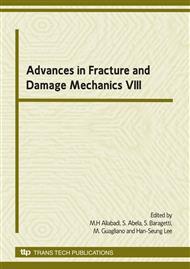p.125
p.129
p.133
p.137
p.141
p.145
p.149
p.153
p.157
On Three Dimensional Curved Crack Propagation Based on Configurational Forces
Abstract:
A numerical scheme is presented to predict crack trajectories in three dimensional components. First a relation between the curvature in mixed-mode crack propagation and the corresponding configurational forces based on the principle of maximum dissipation is reviewed. With the help of this, a numerical scheme is presented which is based on a predictor-corrector method using the configurational forces acting on the crack together with their derivatives along real and test paths. It is outlined how to extend the approach to three dimensional problems. With the help of this scheme it is possible to take bigger than usual propagation steps, represented by splines. Essential for this approach is the correct numerical determination of the configurational forces acting on the crack tip. An approach valid for arbitrary non-homogenous and non-linear materials with mixed-mode cracks is presented. Numerical examples show, that the method is able to predict the crack paths in components with holes, stiffeners etc. with good accuracy, saving much computational effort.
Info:
Periodical:
Pages:
141-144
Citation:
Online since:
October 2009
Authors:
Price:
Сopyright:
© 2010 Trans Tech Publications Ltd. All Rights Reserved
Share:
Citation:


